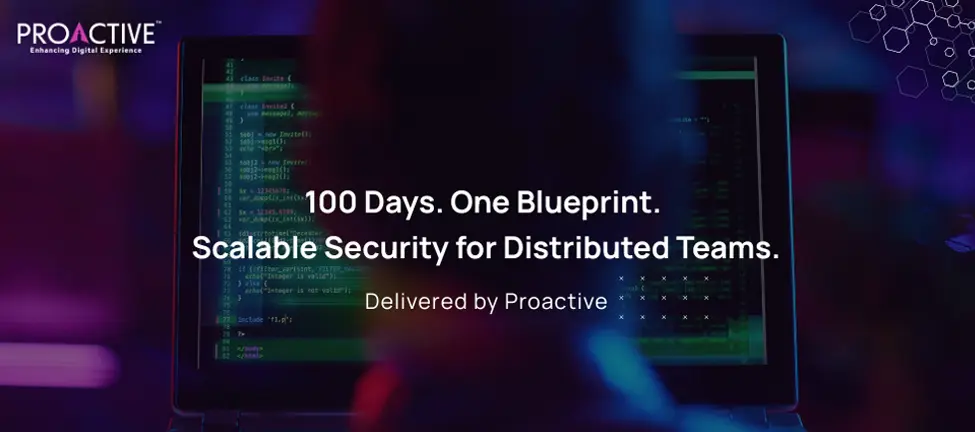Updated: August 03, 2025

Security isn’t a stack. It’s a habit. Proactive builds it in from day one.
The incident started with a contractor in Noida. A personal laptop, shared credentials, and access to an internal dashboard. The alert came 17 minutes later, from a login attempt in Hanoi flagged by the identity provider. That contractor had left the project three months ago. Your SOC isolated the session. The board never found out. But you did. You also knew this wouldn’t be the last attempt.
For Indian enterprises with teams scattered across Pune, Hyderabad, Chennai, and dozens of vendor and partner locations, scaling cybersecurity is a condition for survival. The challenge isn’t buying more tools. It is in building an architecture that secures without slowing, adapts without gaps, and works across functions, geographies, and cloud platforms.
This is what scaling cybersecurity looks like across 100 days, in a real enterprise, under real pressure.
Takeaway: Identity is your real perimeter. Start there, or everything else leaks.
You start with identity. Your team pulls user directories from HRMS, AD, and half a dozen SaaS platforms. The count is off by 14 per cent. One contractor in Mumbai still has access to a shared OneDrive folder. An intern who left six months ago still shows up in Slack.
Access sprawl is your first problem. You standardise identity through a unified directory and begin enforcing MFA across apps. Cisco Duo goes live for VPN and email. Proactive configures conditional access policies for logins outside India. One policy removes 80 per cent of the noise.
Takeaway: If you can’t see your SaaS sprawl, you can’t secure it.
Next comes your SaaS estate. Marketing uses Figma, Finance uses Razorpay, and Sales has a Zapier script pulling data from Google Sheets. No central IT team has visibility into usage, let alone risk. Shadow IT lives here.
Proactive deploys a CASB to discover SaaS usage across your distributed users. Dozens of applications surface. Some harmless. Others worrying. You define usage tiers. Business-approved, IT-monitored, and blocked. Access to apps is controlled through identity federation.
Takeaway: Stop trusting the network. Start authorising by role and context.
You now shift focus to access policies. Site-to-site VPNs are still active between your Bengaluru office and your AWS VPC. Once trusted, now risk-prone. Proactive helps you move to microsegmentation.
Workloads are grouped. Access is defined by identity, not IP. The DevOps team in Hyderabad can no longer SSH into production VMs by default. Lateral movement is stopped before it starts. Policies apply whether the user is in-office or remote.
Takeaway: What your IT team doesn’t manage can still be exploited.
In your plant outside Nagpur, IoT devices still connect through unmanaged switches. A PLC sends data every 45 seconds to a control system that IT never touched. Security here is not optional; it is overdue.
Proactive runs a full network scan across OT devices. You discover legacy systems still running open protocols. VLAN segmentation is applied. Policies isolate OT traffic from the corporate network. Access to HMIs is locked to plant floor terminals.
Takeaway: Visibility without correlation is noise. Invest in intelligence, not alerts.
The goal now is speed. With identities managed, SaaS controlled, and OT isolated, your SOC begins real detection work. Not chasing false alerts, but investigating actual behaviour anomalies.
An identity analytics engine is deployed. User logins across geos, devices, and schedules are scored. A login from Gurgaon at 3 A.M. on a Sunday triggers an alert, not because of location, but because that user never logs in at that time. It is flagged, validated, and contained.
Proactive’s SOC integrates SIEM, EDR, and XDR under one dashboard. It stops being a monitoring center. It becomes an intervention system.
Takeaway: Resilience is your real metric. Can you isolate and recover before damage spreads?
You know incidents are coming. You now ask different questions. Can we isolate a user in under 3 minutes? Can we restore cloud access in 10? Is the backup clean, tested, immutable?
Proactive runs breach simulations. Your IT team executes tabletop exercises. HR, Legal, and Comms join. You simulate a ransomware event at your Chennai hub. Recovery happens in under 45 minutes.
Insurance premiums drop. Your CISO finally reports readiness instead of risk.
Takeaway: You don’t scale security by scaling tools. You scale process, visibility, and trust.
What began as a security overhaul is now an operating model. Your onboarding process automatically provisions identity, access, and app policies. Offboarding triggers revocation, logs, and audit trails.
Vendors are onboarded via zero-trust portals. Temporary access has an auto-expiry. Support teams in Bengaluru and Jakarta now follow the same playbook. No exceptions. No shortcuts.
Proactive transitions your environment to continuous monitoring. Compliance reports are generated automatically. You stop preparing for audits. You start reviewing them.
Takeaway: A distributed workforce needs a distributed defence. Built-in. Not bolted on.
Your distributed workforce is not an edge case. It is the new structure. Scaling security across it is not just a tech problem. It’s a coordination problem, a visibility problem, and a process design problem.
Proactive Data Systems brings architecture, services, and monitoring into one stack. Not sold in parts, but delivered as outcomes. Our teams work where your teams are. From Noida to Coimbatore. From factory to AWS. When your business expands, your security should not need a reboot. It should expand with it.